Landscape Plants for Fire Safety
Year-round interest from choice plants
By Dave Egbert*, adapted from Pacific Horticulture, October, 2012
Fire safety at home has become a hot topic for rural and suburban gardeners as the number of homes destroyed by raging wildfires has increased. Buildings in the wildland/urban interface—that space where nature is pushed aside to make way for people—are especially vulnerable if fire safety is not factored in at every stage of planning and development.
Flying firebrands, embers blown on the wind ahead of the flame front, are a major wildfire threat. Firebrands can travel great distances and lodge in the corners and crevices of a home or ignite an overgrown landscape crowding close around it. Even a home sited in acres of parking lot is vulnerable to flying firebrands.
Designing homes with common fireproofing features like fire-resistant surfaces and finishes, minimizing roof eaves, removing overhanging decks and fencing, and avoiding dense, invasive, or poorly maintained landscaping is critical to fire safety. Avoid building structures in natural chimneys such as at the top of a narrow canyon or close to the edge of a steep slope.
Landscaping for Resilience and Safety
The fire-safe garden can be a rich and colorful landscape, offering year-round interest and beauty while doubling as an important tool in the fight against wildfires. The purpose of a fire-safe landscape is two-fold:
- Reduce flammable material closest to the home. Flying firebrands will have little purchase in a green landscape composed of low-fuel volume plants. In the absence of the homeowner or a fire crew, a landscape of fire-resistant plants can help to slow the spread of fire around the home.
- Maintain open space around the home to allow firefighters and their equipment to safely operate without having to deal with masses of nearby burning material.
When choosing plants for the fire resistant garden, look to plant retailers like High Country Gardens or Annie’s Annuals as your source, and use the gardens of Scott Ogden and Lauren Springer-Ogden as your guide. Their book, Plant Driven Design, (Timber Press, 2009) offers a wealth of low-water-use, colorful, and casual plant combinations that are perfect for low-fuel gardens in the “Lean, Clean, and Green Zone” closest to the home. This is the area within 30 feet of the home where firefighters will do hand-to-hand battle with flames. Farther from the home, in the next 100 feet from the walls, nature-inspired plantings include masses of perennials, roses, and well-spaced native and introduced shrubs with carefully placed trees as accents.
Plant choice is important, but annual maintenance is critical. Fresh, green growth is less likely to burn during a wildfire and, in the case of perennials, allows them to simply wilt instead of adding more fuel to the fire. Remove dry, dead material from the centers of shrubs, trees, and vines to reduce their vulnerability to flying embers.
A Fireman’s Favorites
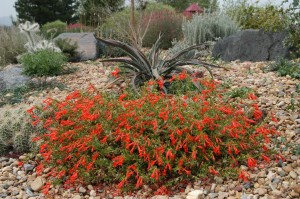
Orange Carpet hummingbird trumpet at Kendrick Lake gardens, Lakewood CO
I love native plants, but often the focus is primarily on spring color with little consideration for the other seasons. California fuchsia, sometimes called hummingbird trumpet, (Epilobium canum subsp. garrettii) is a California native that adds color and spark to late summer gardens. I have found Epilobium to have the heft of a shrub without the twiggy mass, and the plant benefits from hard pruning after frost to clear away the old growth.
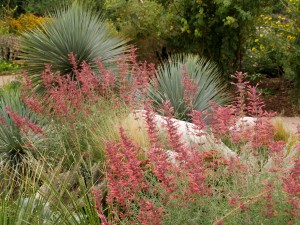
Sunset hyssop (Agastache rupestris) by Dan Johnson at Denver Botanic Gardens
Hummingbird Mint (Agastache) offers impressive color and fragrant foliage. The plants grow best in hot climates with deep soil and should be watered well at the onset of blooming to prolong the flowering season. Agastache rupestris and A. aurantiaca can grow to four feet tall and as wide in a single summer, but they may take a while to get established in cooler coastal gardens. Agastache blooms purple, pink, peach, salmon, or orange—a blend of shades that contrast well with lavender.
Garden asters are another often–overlooked choice for fall garden interest. Numerous cultivars of this large plant family offer strong color in late summer when many other perennials are fading. A perfect foil for late-summer roses—and when pruned back hard in late fall to remove spent foliage—asters are another fire-safe favorite. James Van Sweden showed me his passion for simple native asters such as Aster divaricatus ‘Raiche Form’ and A. oblongifolius, which was chosen as a Missouri Botanical Garden Plant of Merit in 2003. In his bayside Maryland garden, I admired how they grew in free-form masses among the grasses and rudbeckias and under copses of trees.
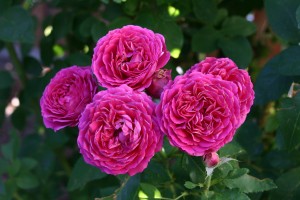
Ruby Voodoo rose. Photo by Pat Hayward
My inclusion of roses in a fire-safe landscape rankles many people who do not recognize their adaptability. In my experience, many roses—especially hybrid musks and landscape roses—are amazingly tough and will weather any challenge with grace and beauty. Rosa glauca has incredible purple-tinted (glaucous) foliage dotted with tiny pink blooms in early summer followed by showy orange hips in fall. The common landscape rose ‘Flower Carpet Red’ cannot be beat for its masses of red semi-double blooms and outright vigor.
Groundcovers are the workhorses of the fire-safe garden. They carpet the ground with foliage and flowers, yet offer ideal low-fuel volume that is essential nearest to the home. A well-maintained groundcover, whether it is a low-care lawn of UC Verde® buffalograss (Buchloe dacryloides), a carpet of iceplant (Delosperma), or layers of native Manzanita (Arctostaphylos) can help snuff out firebrands that land near the home.
Succulents are often portrayed as the ultimate fire-safe plants. In her wonderful book
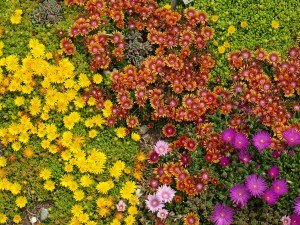
Yellow, Table Mountain, Fire Spinner and Lavender Ice ice plants. Photo by Lisa Brown
Hardy Succulents, Gwen Moore Kelaidis lists a colorful spectrum of hardy South African ice plants including the spectacular purple-flowered Delosperma cooperii, which has become common on nursery benches throughout the West. Fire Spinner®, a recent ice plant introduction, should prove to be a knockout in the garden.
Groundcover sedums are gaining popularity with the introduction of several improved southwest natives. I still prefer Sedum album, which could almost be called a weed for its ability to fill in around other plants like a living mulch while sporting grass-green foliage and shining white blooms in late summer. I’m also impressed by spreading prickly pear (Opuntia fragilis f. denudata) which forms highly textured carpets of jointed, prickly stems topped with watermelon-pink or satin-yellow blooms.
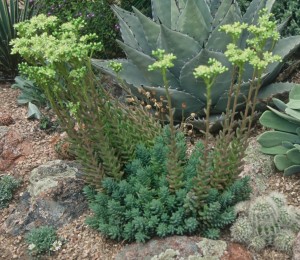
Turquoise Tails blue sedum, photo: Lauren Springer Ogden
Seasonal bulbs are perfect groundcover companions. Spring-, summer-, or fall-blooming bulbs might just be the ultimate fire-safe choice. They disappear without a trace when dormant, sheltered from the flames below ground, only to emerge like the Phoenix from charred earth. Choose from a wonderful selection of ornamental onions (Allium sp.), which fit into wild and refined gardens alike. I especially like drumstick allium (Allium sphaerocephalon) with deep purple blooms on slender one-foot stems which increase slowly but dependably in dry soil. Larger flowered types, such as A. christophii and A. giganteum, perform best with summer water.
Education, maintenance, and good plant choices are the foundation of a fire-safe garden where everything comes together to create a vibrant outdoor living area, providing year-round interest for you, while giving firefighters a fighting chance to help save your home from a wildfire.
Related Article: A Fire-safe garden resource guide by Dave Egbert
Fire-Safe Dos and Don’ts
DO:
• Limb up trees 10 feet or more above the ground within the first 100 feet of the home.
• Open up and exaggerate spaces between the natural landscape and cultivated plantings.
• Remove old, dried-out, or drought-stressed specimens in favor of healthy, strong plants and clear dead material from mature trees and shrubs.
• Control invasive weeds by keeping soil covered with mulch, gravel, groundcovers, bulbs, and wildflowers.
• Keep areas closest to the house free of weeds, litter, and woodpiles and keep these areas mulched with gravel or other nonflammable materials.
• Irrigate plants close to structures within the first 30 feet of the home—the so-called Lean, Clean, and Green Zone—to keep foliage moisture levels high in summer and fall.
• Reinvigorate shrubs and perennials with regular pruning and remove old plants with dense masses of dry growth.
• Choose built-in hardscape features like seat walls and low benches in place of flammable wood or plastic patio furniture.
DON’T:
• Remove low-growing herbs and leaf duff to expose bare soil that encourages invasive weed growth.
• Clear-cut areas down to bare soil, which promotes erosion and weed growth.
• Replace native vegetation with highly flammable non-native plants such as juniper, pine, and tall ornamental grasses.


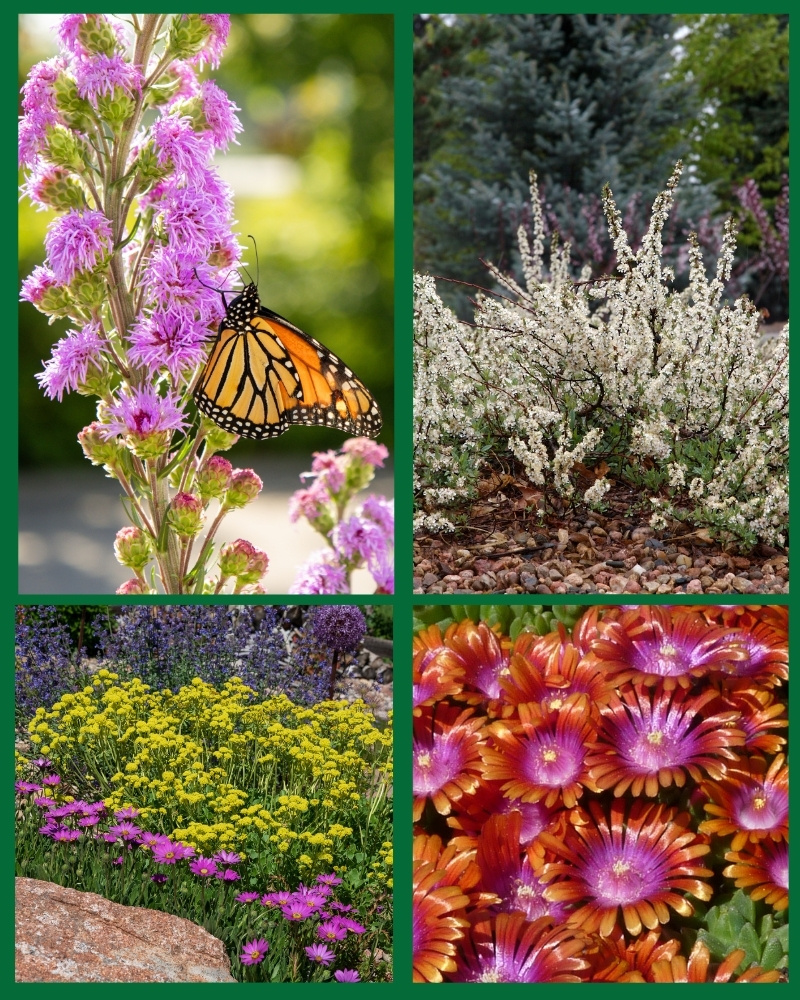
Are any trees recommended in the clean, green, lean zone? We have some native scrub oak and old ponderosa w/in 30 ft. of the house. Do you recommend they all come down?
Thanks!
That is hard to determine without more information. Each situation is going to depend. Check with a local fire marshall for an official answer.
I had two beautiful Ruby Voodoo Rose bushes in my yard and removed them because they were magnets for Japanese Beetles. It was a sad experience, but it taught me a lot about these insects and what to plant to keep them away.
I really appreciate the warning about Japanese beetles on ruby voodoo. I was thinking of getting but has been wondering about the beetles.